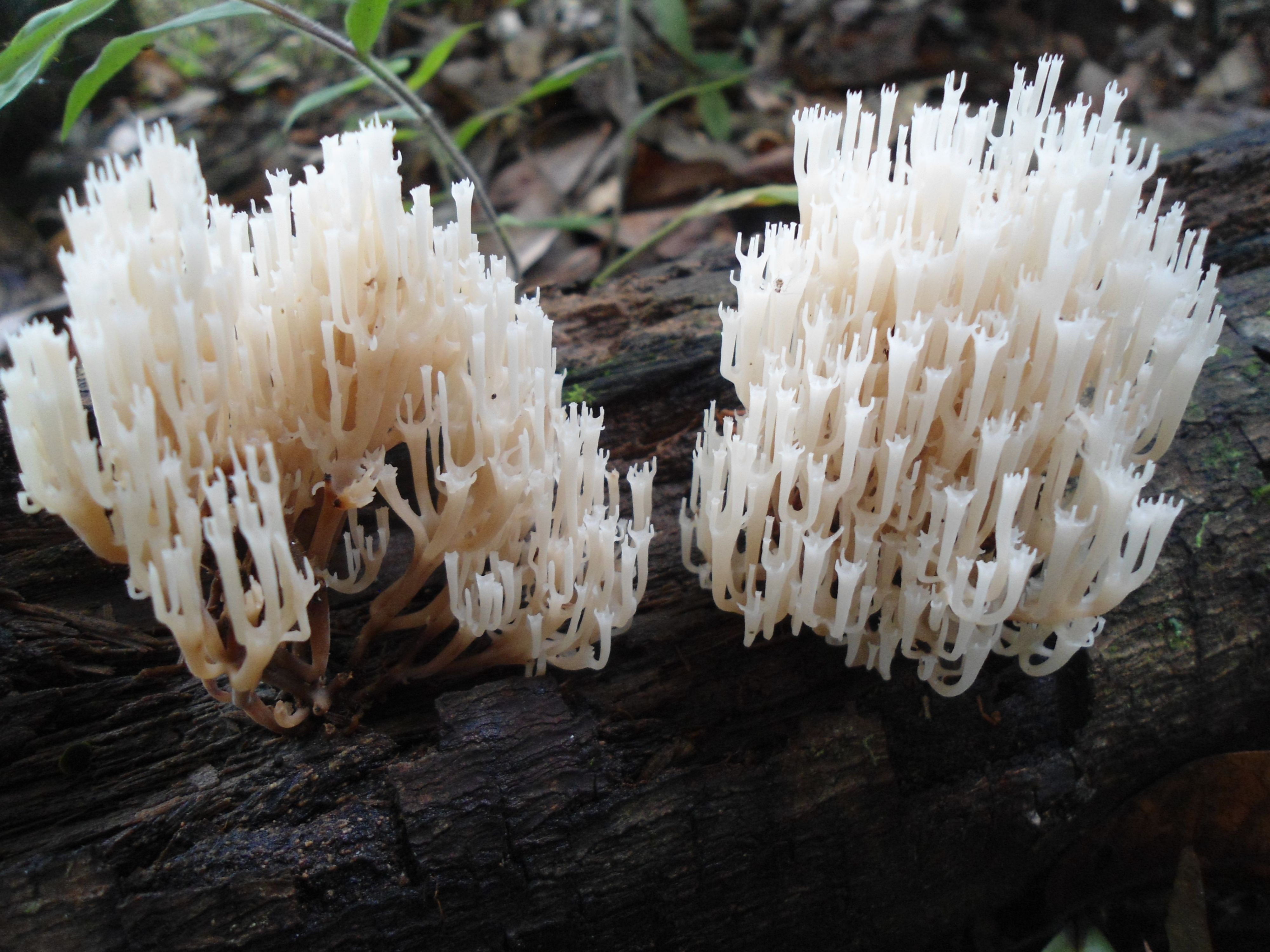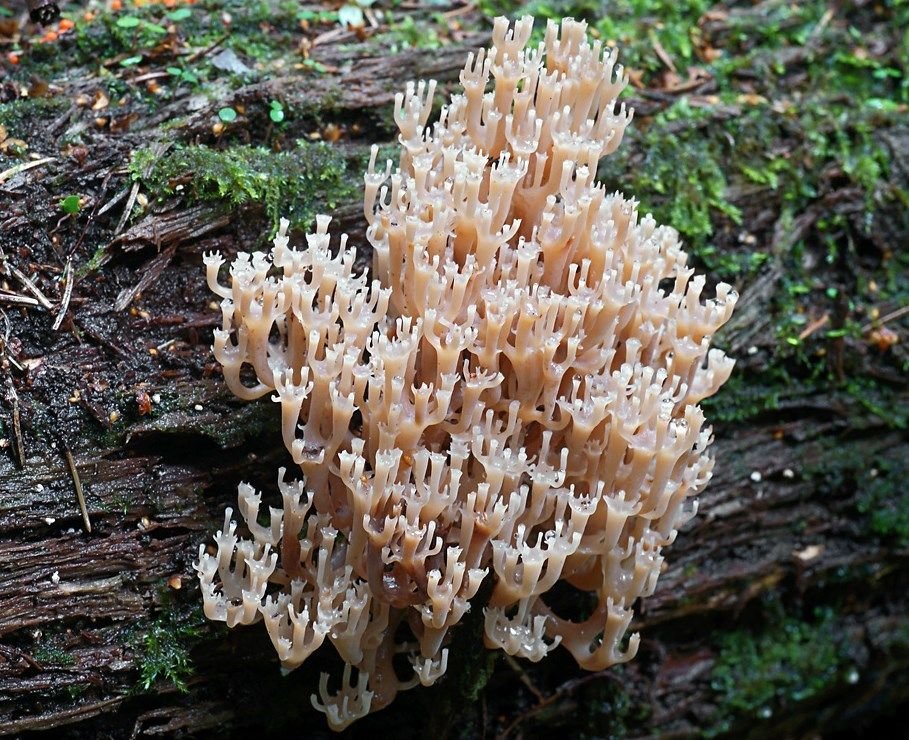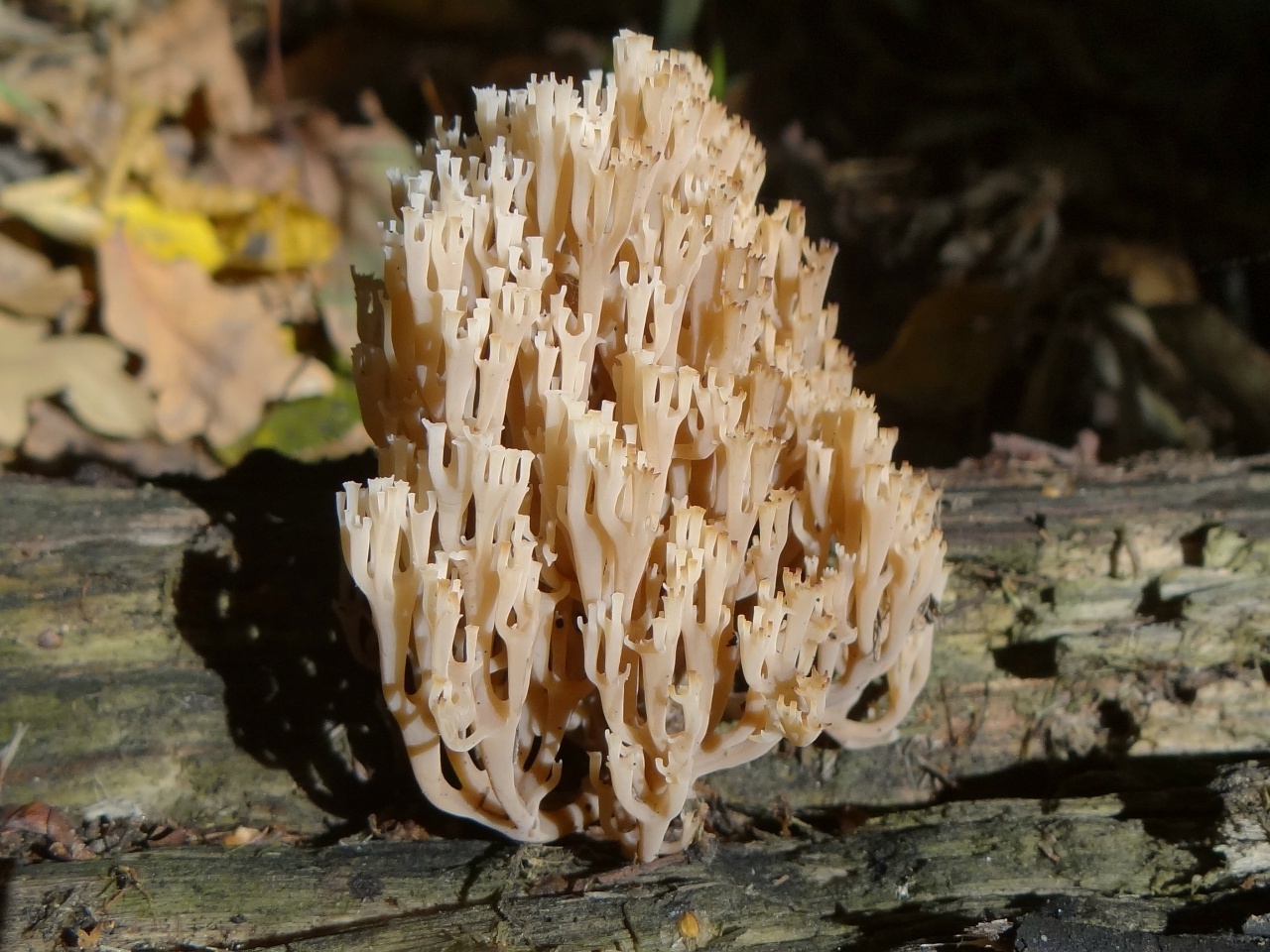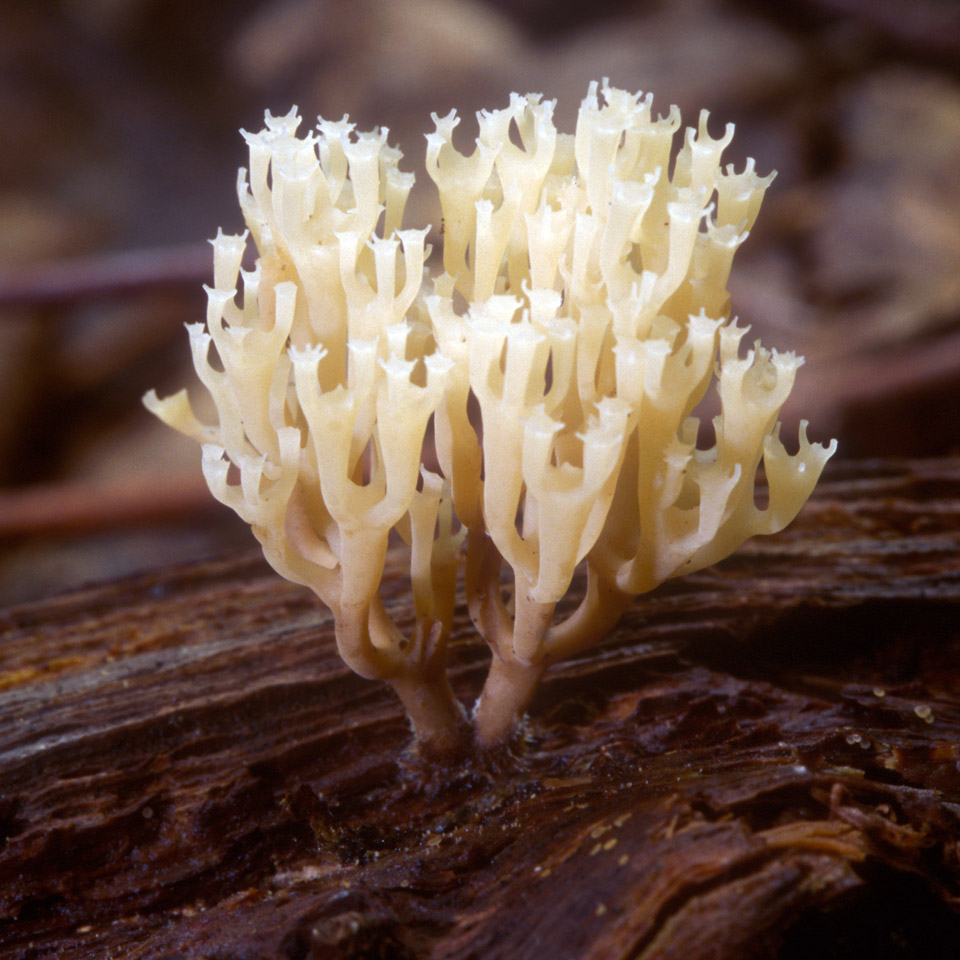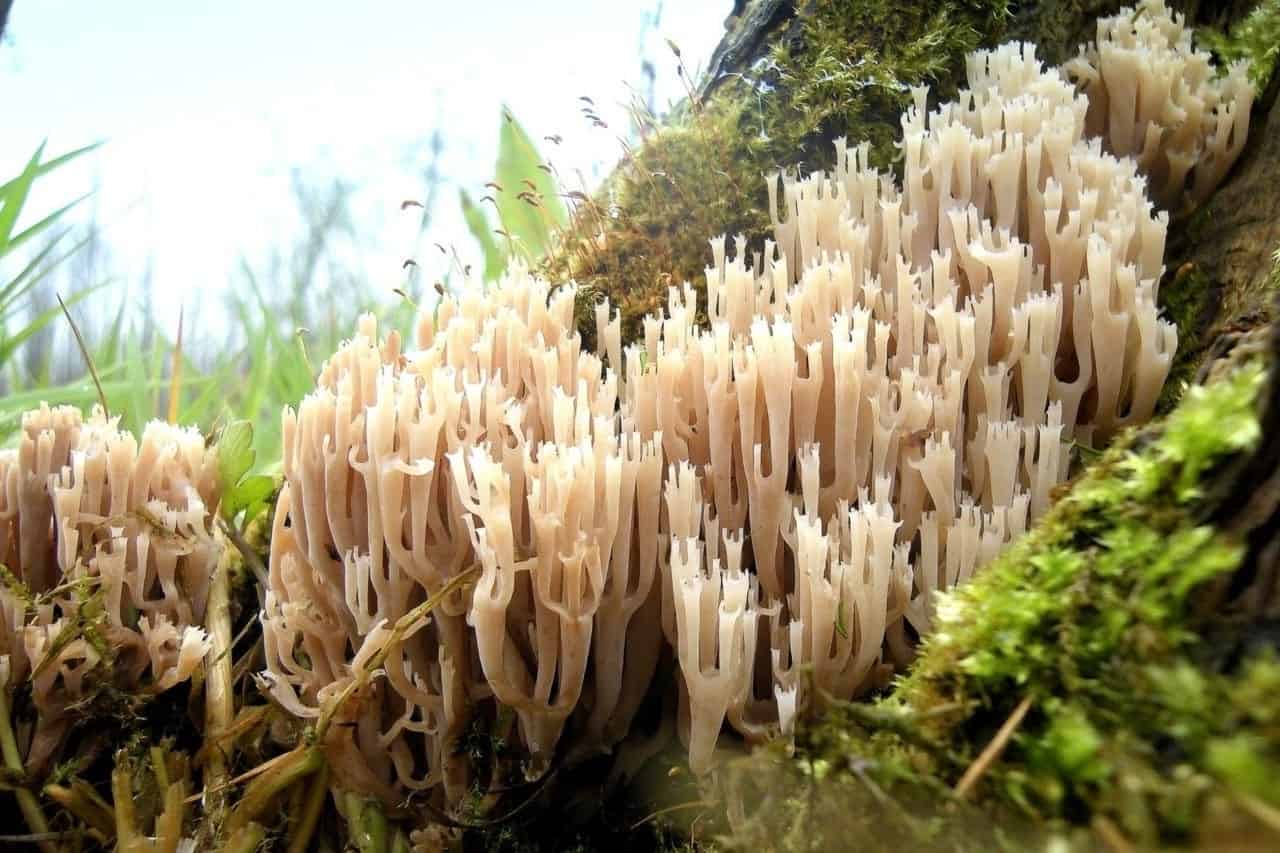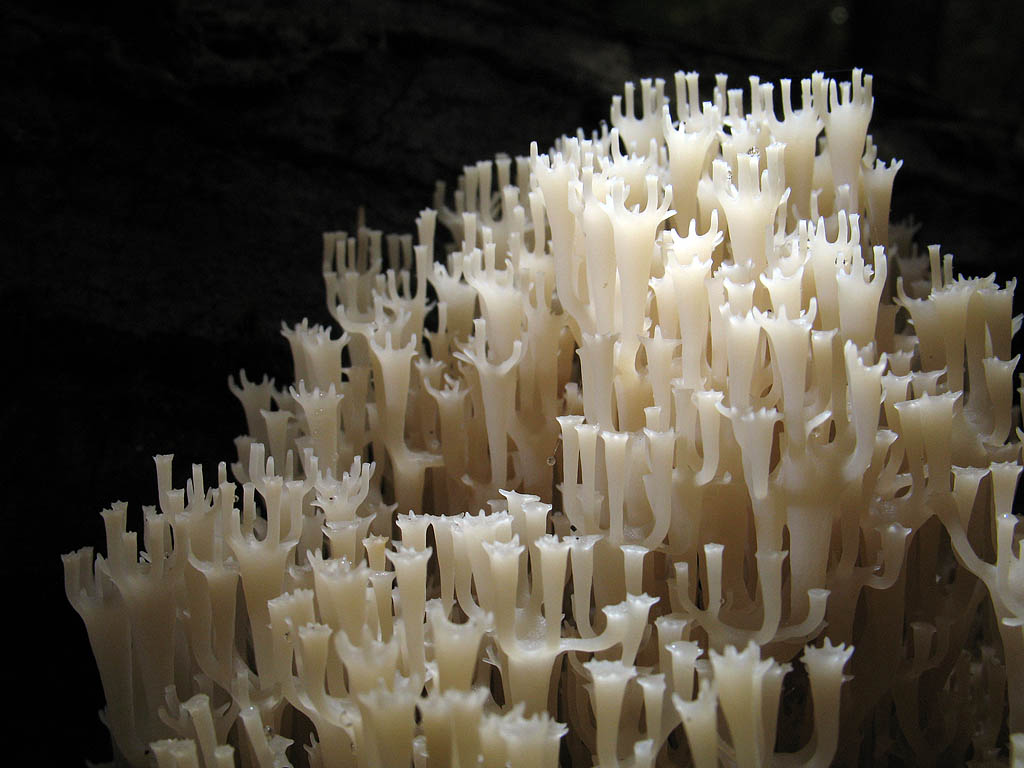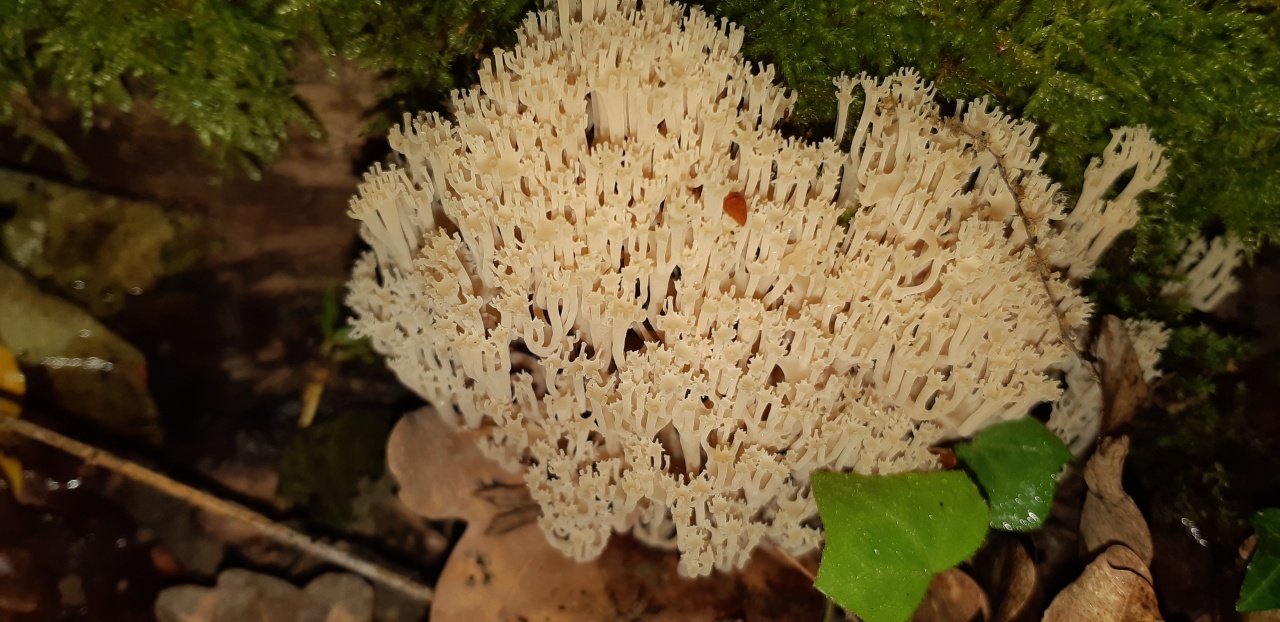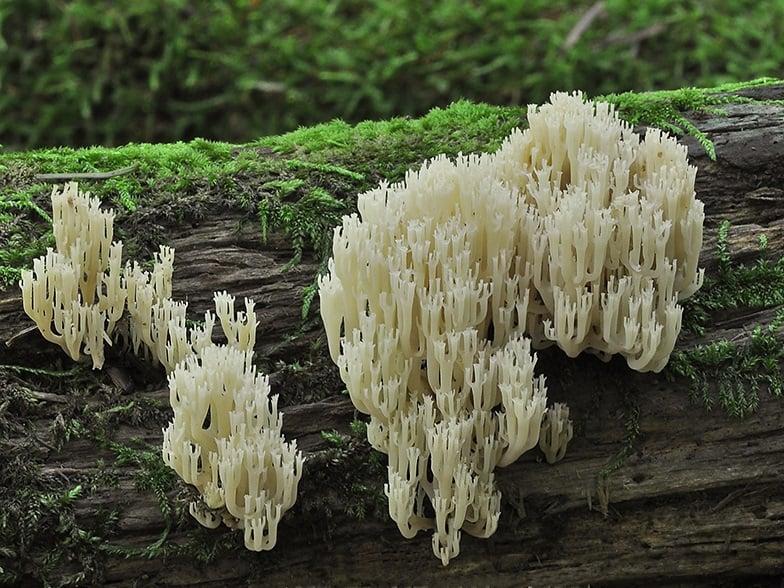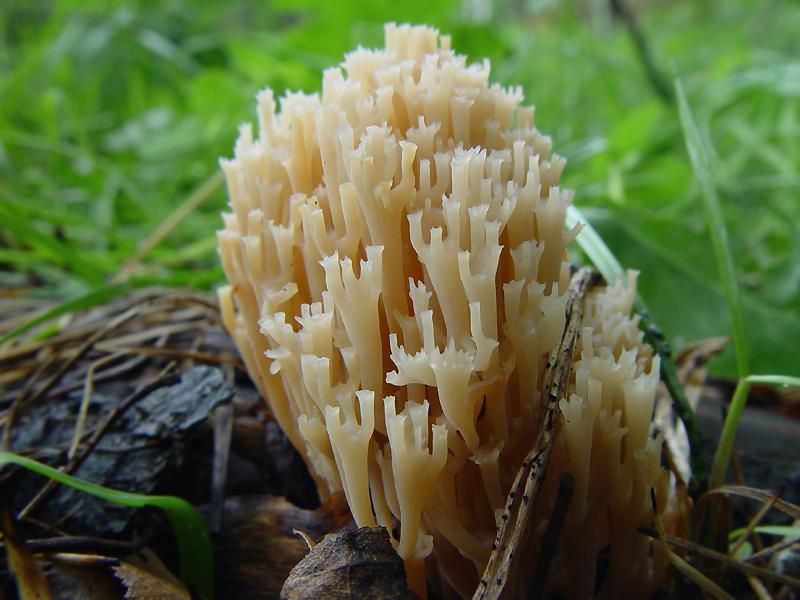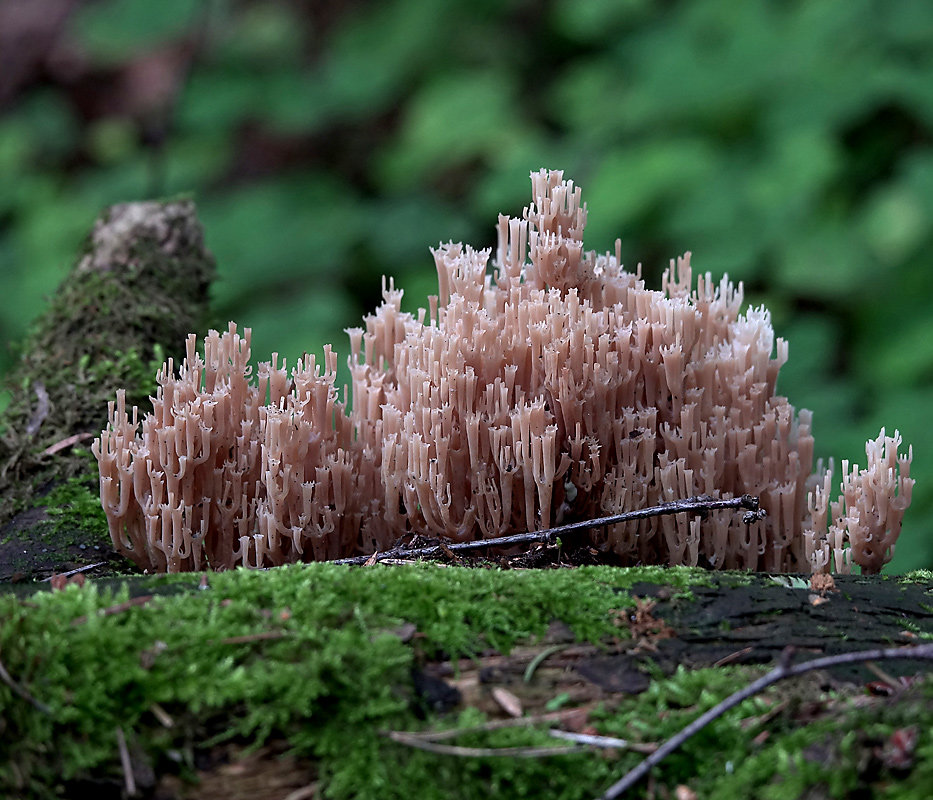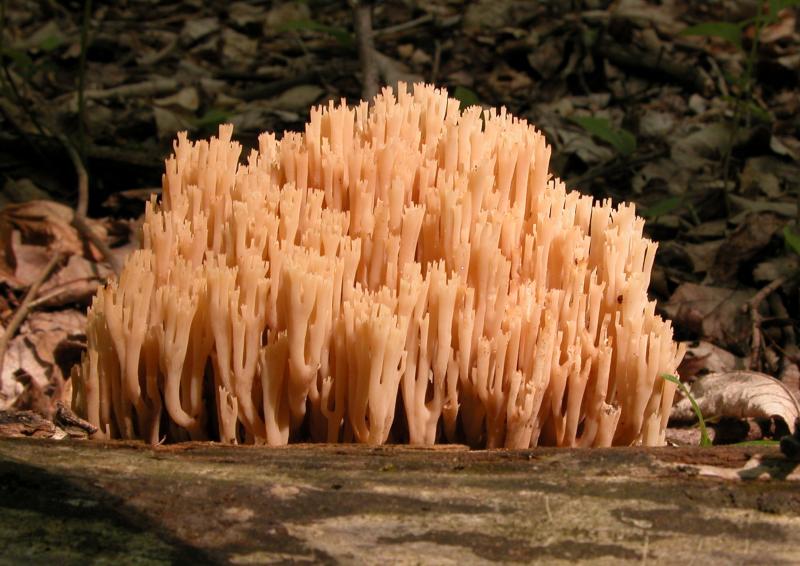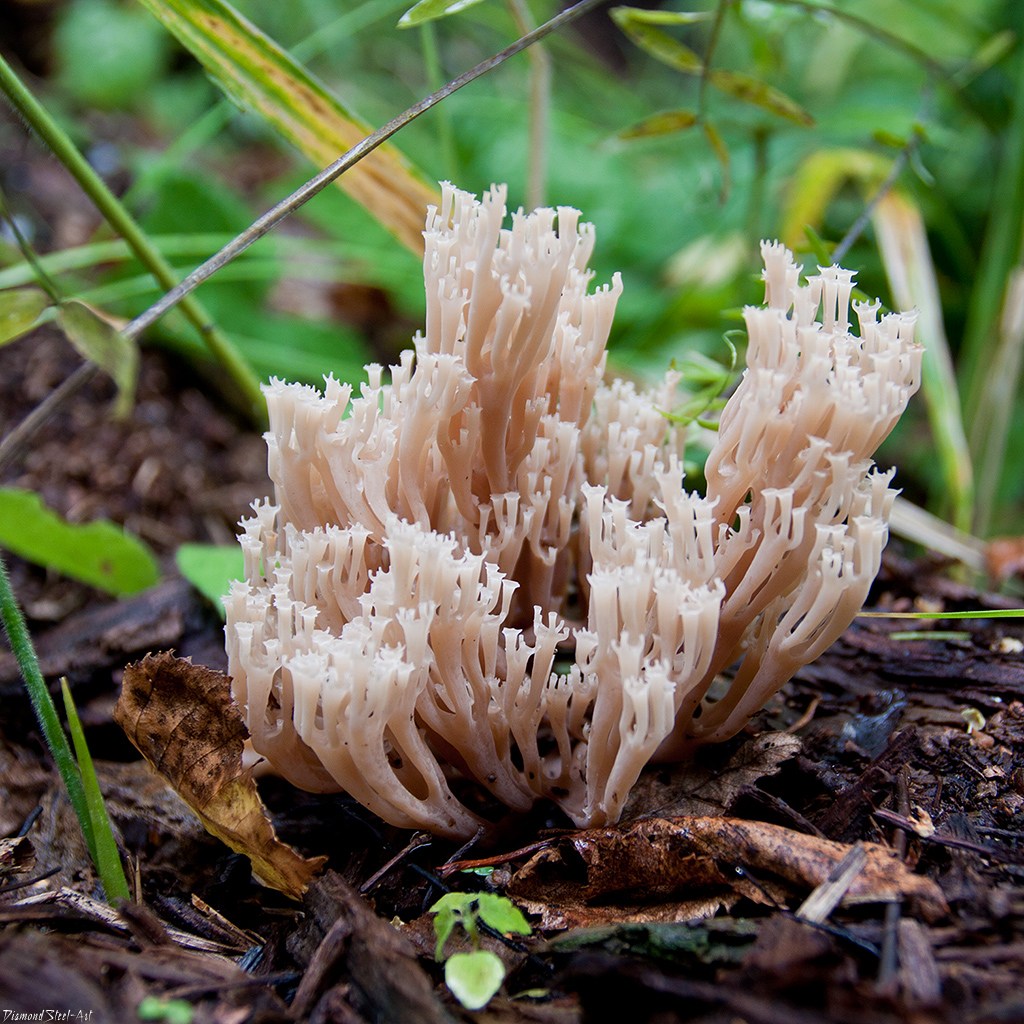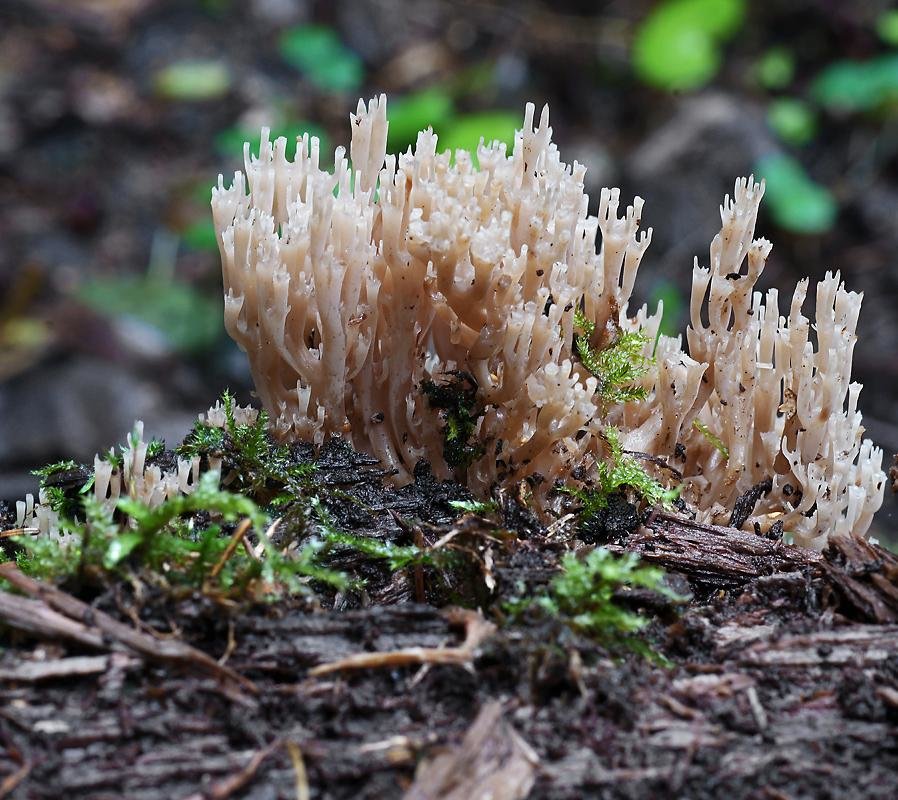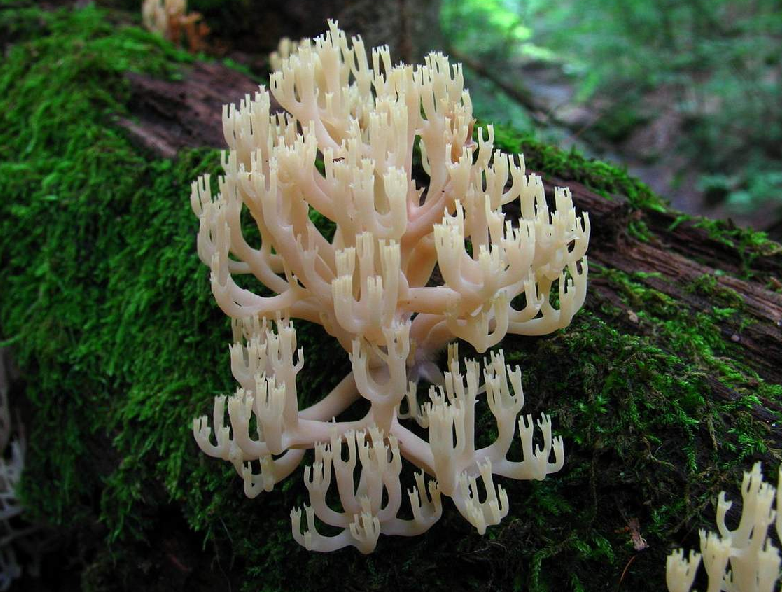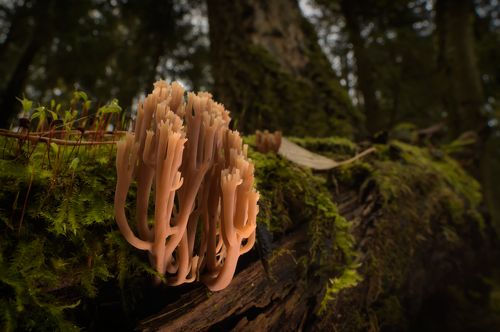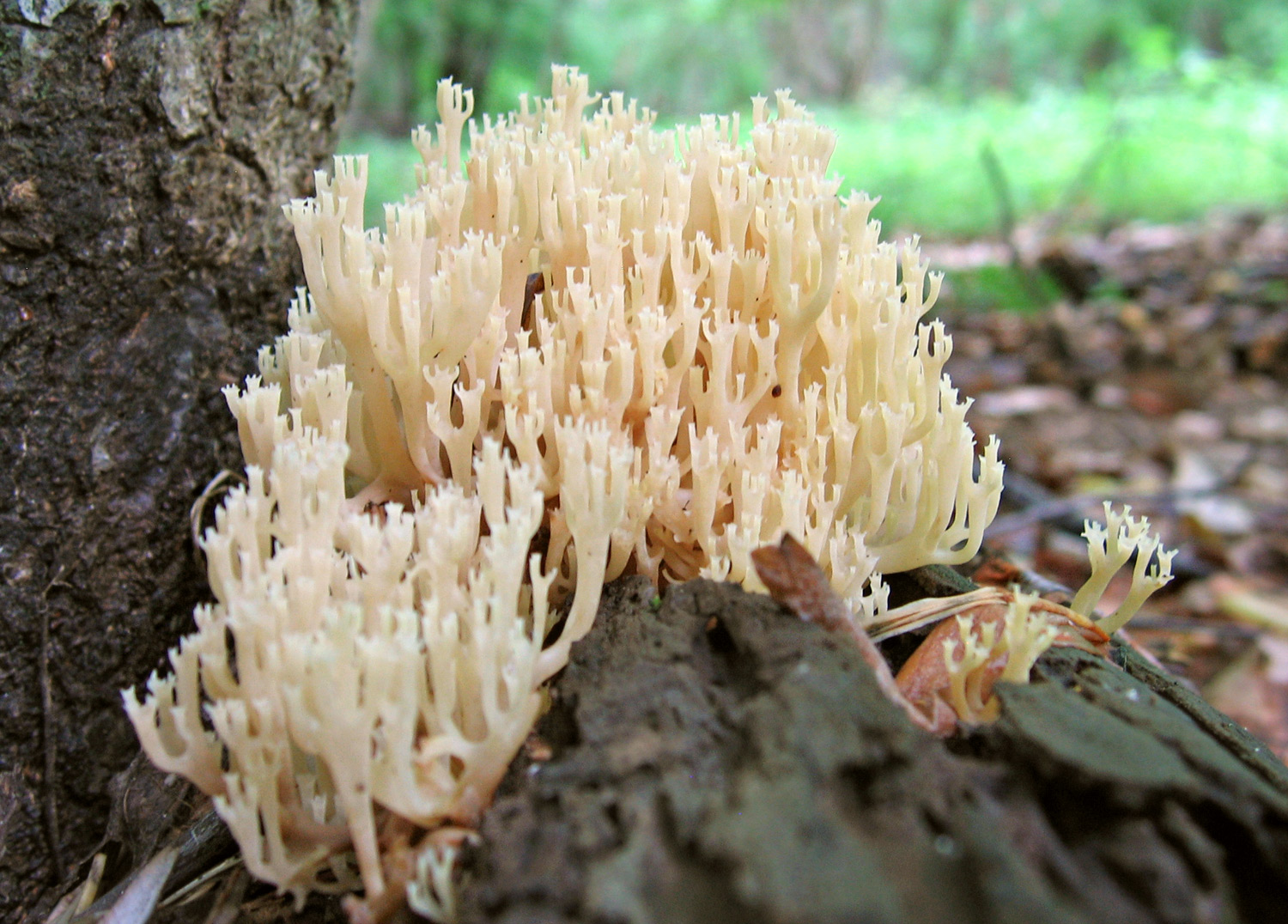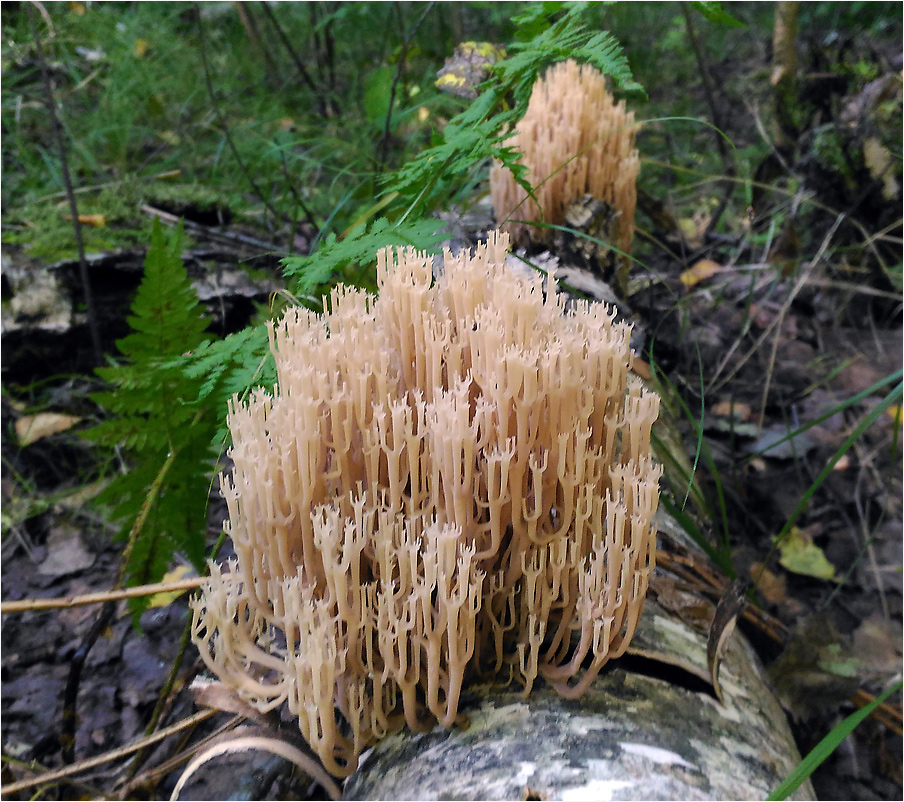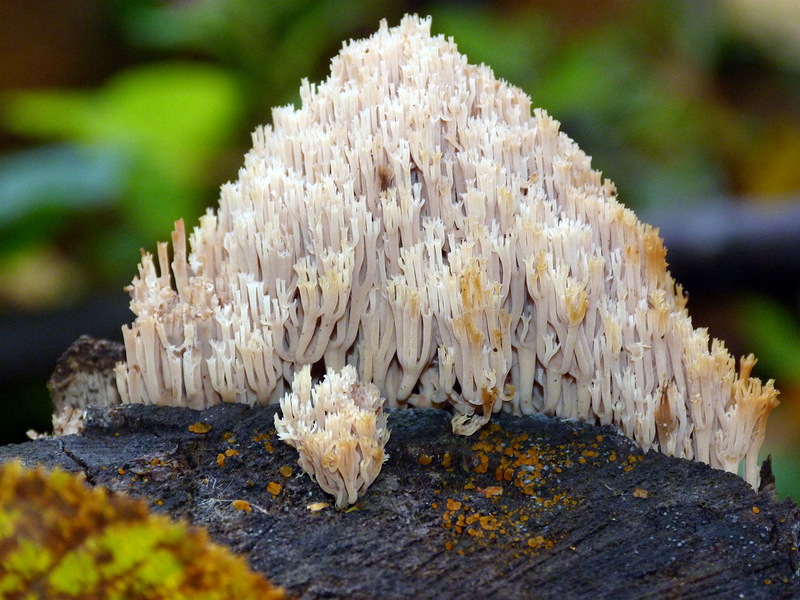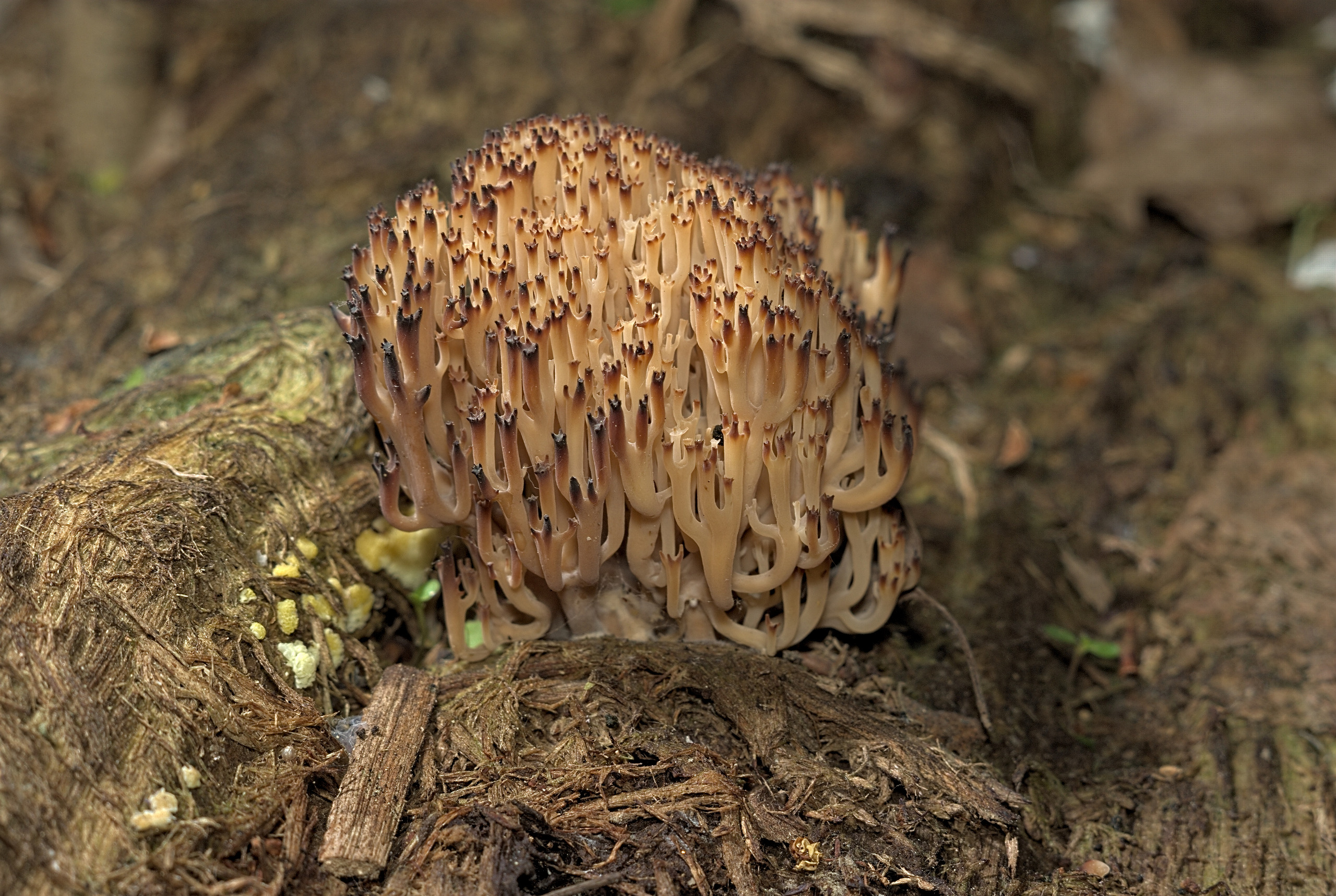Horned coral. Horned mushrooms
Horned is the common name for basidal mushrooms.
General description Fruit bodies are erect, rod-shaped, clavate or branched in the form of a bush. Coloring is white, gray, yellow, cream and other colors. Inhabits forests on soil, litter and rotten wood. Many are edible, but they are not usually harvested by the population. There are no poisonous, dangerous to human life. But there are inedible ones, with a bitter taste or an unpleasant odor.

Conditionally edible
Lat:
Synonyms: Horned yellow, Bear's paw, Deer horns, Coral yellow.
74813
10
Clavicorona cryotate
Lat:
Artomyces pyxidatus
Synonyms: Artomyces pryniform, Box clavicorona, Deer horns, Mushroom cabbage, Mushroom noodles, Clavicorona pyxidata.
15336
15
10478
5
Ramaria ordinary
Lat:
Ramaria eumorpha
Synonyms: Inval's Horn, Spruce Horn, Ramaria Invalii, Clavaria invalii, Clavariella eumorpha.
Light ocher, yellowish bushes of Ramaria Intvala are often found in coniferous forests, it is one of the most common types of Ramaria.
Specifications:
Shape: coral
7124
2
Clavulina coral
Lat:
Clavulina coralloides
Synonyms: Horned crested, Clavulina comb, Clavulina cristata.
Categories: K, Inedible mushrooms
6826
3
In coniferous or mixed forests, height 7-12 and thickness 1-3 centimeters
Specifications:
Shape: clavate
6321
2
Narrow, high: up to 10-15 cm high, up to 1 cm thick at the widest part. In deciduous and mixed, oak, aspen, birch are needed.
Answers to common questions
The unusual shape of mushrooms raises a lot of questions from mushroom pickers:
When collecting any mushrooms, some rules should be strictly observed: the crop is cut, not plucked by the root; the soil and moss in the forest should not be stirred up or dug up too much; picking mushrooms in reserves is prohibited; mass collection of any species will certainly lead to its extinction.
The rubbery flesh of a calocera has a reddish tint. The false mushroom has no taste and smell. The fruit body has pointed branches and is colored dark yellow or orange. True yellow corals are very similar to calocera, for which the cartilaginous and gelatinous consistency of the fruit body is not characteristic.
The coral hedgehog is one of the more unusual members of its family. It is famous not only for its interesting shape, but also for its good taste. But when collecting this species, you should be extremely careful, because it can be easily confused with false corals.
This conditional division of mushrooms by type was made by me for the convenience of searching and comparing mushrooms by appearance. From all the variety of shapes, species and colors, I decided to single out individual groups according to my own understanding. It may not seem very convenient for you, but the encyclopedic search is always at your service. Warguns - to this species I include all mushrooms with a stocky thick leg and a tubular cap. OBABKI - porcini mushrooms, aspen mushrooms, boletus mushrooms and similar large mushrooms, including Tsarsky obabok (Far Eastern obabok). OILS - small tubular mushrooms and the like, usually with a thin stem and a soft cap. LOADS - here I put white lamellar mushrooms, mushrooms, pigs of all stripes and, of course, milk mushrooms. WHEELS - apart from the red, blue and green russula themselves, here you will find Valui, Caesari and similar lamellar mushrooms, brittle and not as dense as milk mushrooms. on the ground. Chanterelles - hedgehogs and several species of chanterelles are here together due to the similarity of taste and cooking methods. RAINCOATS - strange white balls, piccherichki, champignons, truffles and brutes - all this is collected here.
Edibility, description and photo of Artomyces pryniformis
Mycologists also call the box clavicorona Clavicorona prynate or Artomyces prynate (in Latin Clavicorona pyxidata or Artomyces pyxidatus), and it is popularly known as "antlers".
A cute, coral-like mushroom, Artomyces porciformis is very common in our country and in the world. It looks like a colony of individual fungi growing vertically, although in fact it is a single fruiting body. It's just very ramified.Each branch up to 1 cm thick, up to 3 cm long, re-branched, forming 4-6 processes, each of which ends in four teeth forming a crown (hence the second Latin name for the mushroom). The size of the fruit bodies of arthomyces is very different, from very small, 4x2 cm, to large, 20x15 cm.
The color of the fruit bodies varies from whitish-yellowish to pinkish and brownish. "Crowns" the same color as the body, or slightly darker. The leg is missing or very short.
It seems that arthomyces is a very fragile mushroom. But this is not the case. The pulp of the mushroom is white, it is not fragile at all. On the contrary, elastic and tough. The smell is very subtle, earthy. The pulp tastes soft at first, and then gives a sharp, scalding taste, according to many, reminiscent of black pepper.
Admire the Clavicorona Cryotus in the places where it grows:
The existence of this species, at least for now, is not threatened. Perhaps this is due to the fact that scientists and culinary specialists cannot decide in any way whether it is edible. In different reference books, it is classified into different categories, from inedible (solely due to the hardness of the pulp) to edible. This type of mushroom does not relate to poisonous, although there is information about digestive disorders in people who have eaten this beautiful mushroom. Most researchers are inclined to the conditional edibility of this mushroom - it can be eaten if it is preliminarily processed in a certain way. By the way, in the literature there is information that boiling enhances the sharpness of the taste of Artomyces pryniform. But, since there is no dispute about tastes, some people like the taste of clavicorona so much that they come up with salads with it.
Description
Deer horns (Ramaria flava), a branchy yellowish conditionally edible mushroom, also has the name bear's paw and yellow coral.

It is characterized by the following distinctive features:
- the total height of the fruiting body reaches 20 cm, the maximum diameter is also 20 cm. The color, initially creamy, yellowish, lemon or sulfur-yellow, eventually becomes ocher to orange. The flattened "branches" are repeatedly split U- or V-shaped, have equal length, somewhat blunt ends;
- the leg grows up to 8 cm in length and 5 cm in thickness. It is colored in shades of yellow characteristic of the whole mushroom, brightens towards the base. In places of pressure it becomes reddish-brown;
- spores are pale ocher, formed on the outer surface of the fruiting body;
- fragile pulp of watery consistency, light, yellowish, with a faint pleasant odor. As it ripens, it becomes bitter, especially in the "twigs".
Deer beard mushroom. Yamabushitake (Hericium Erinaceus)
Yamabushitake, also known as lion's mane mushroom, is a dietary mushroom that can be used as a food supplement. Appears to be a cognitive enhancer and immunomodulator (supposed to be able to stimulate or suppress inflammation, depending on various factors).
Other names
Hericium erinaceus, lion's mane, monkey head, houtougu (rare), comb gooseberry, Pom-Pom mushroom, hedgehog mushroom, grandfather's beard.
Notes (edit)
Because the water-soluble extract is considered less potent when taken alone, it is best to take the Yamabushitake supplement directly with food.
Skin irritation can be caused by Nerve Growth Factor and without signs of allergy is not dangerous
Variety
To date, only one trial has been conducted with oral ingestion of 1000mg yamabushitake (96% pure extract) three times daily. While it is not known how optimal this dosage is, it appears to be effective.
Origin
Yamabushitake is a mushroom that grows on old or dead deciduous trees, consumed in Japan and China without any harmful effects on the body.Some common names: monkey head, lion's mane and grandfather's beard, sometimes called houtougu, like a drink for athletes with content of Hericium erinaceus (11th Asian Sports Festival in China, 1990).
Composition
Erinacins A-K
Orcinol derivatives (mycelium)
Sialic acid binding lectin
Sterols such as ergosterol and beta-sitosterol.
And also the polysaccharide component (Hericium erinaceus) - polysaccharides, called HEF-P and belonging to the beta-glucan family, can break down into 4 polysaccharides.The percentage in the fruit bodies is approximately 20%, 18.59% of ethanol extract and the general structure of these polysaccharides includes xylose (7.8%), ribose (2.7%), glucose (68.4%), arabinose (11.3%), galactose (2.5%) and mannose (5.2%) Like most medicinal mushrooms, yamabushitake appears to contain bioactive polysaccharides (carbohydrates) along with ethanol-soluble molecules.
The total phenolic content of yamabushitake is 10.20 +/- 2.25 mg gallic acid equivalents per gram (about 1%) with a hot water drawer, which appears to be five times higher than oven cooking using methanol or in lyophilized fruiting bodies. This content of the phenolic part in 10.20 +/- 2.25 mg of gallic acid equivalents per gram is significantly less than in the preparation quercetin (194.24 +/- 7.58) and, in general, in laboratory studies, anti-inflammatory effect Yamabushitake was more than 5 times lower than that of quertcetin. By themselves, polysaccharides are active in vitro, and taking 300mg / kg polysaccharides per day for 15 days can help reduce inflammation caused by ischemia or reperfusion.
The phenolic anti-inflammatory potential of yamabushitake is significantly lower than that of quertecin and gallic acid, but the polysaccharide component appears to be bioactive.
How to collect reindeer horns mushrooms (video)
Soup
Any housewife can cook it, even one who has never encountered these mushrooms before.
- Water - 3-4 liters;
- deer horns - 300-350 g;
- potatoes - 200 g;
- carrots - 1 pc.;
- butter - 30 g;
- bay leaf - 1 pc .;
- greens, onions, salt, sour cream, garlic - to taste.
- Prepare your slingshots. After pre-cooking, be sure to rinse them again.
- Cut the potatoes into strips and the carrots into thin slices.
- Place the vegetables over medium heat with the bay leaves.
- When the food is half soft, add the antlers and butter.
- After 15 minutes, herbs, onions and garlic are added as desired.
- Wait for the water to boil again, add salt to the soup and turn off the gas.
The dish is especially tasty with sour cream. It is a light and nutritious soup that is often eaten cold in summer.

Reindeer horns mushroom soup can be prepared by any housewife, even one who has never encountered these mushrooms before.
Cream soup
Delicate texture and rich taste are what distinguishes this dish.
- Chicken broth - 1 l;
- chicken meat - optional;
- potatoes - 0.5 kg;
- boiled mushrooms - 300 g;
- butter - 40-50 g;
- vegetable oil - 1 tablespoon;
- cream 10% fat - 0.5 cups;
- starch - 1 tsp;
- seasonings, salt - to taste.
- Cooking the fry. Heat half of the butter and a whole spoonful of vegetable oils in a heavy-bottomed pan.
- Add the onion, cut into thin rings. Pour starch on top.
- The finished onion should turn golden brown. We take it out on a plate.
- Put chopped slingshots in a frying pan with the remaining oil. After 5-10 minutes, turn off the heat and add the onion.
- Boiled potatoes in chicken broth should be chopped in a blender along with meat and butter.
- Pour the broth and slightly warmed cream into the finished puree.
- We heat up the cream soup, but do not bring it to a boiling state!
- Pour in the spices.
- Pour a dish into a plate, put onions and mushrooms in the middle, sprinkle with herbs on top.

Delicate texture and rich taste - this is what distinguishes reindeer horn mushroom cream soup.
Potatoes with mushrooms
Mushrooms go well with any potato, especially horns. You will need as many ingredients as you like.
- Washed black hairs are boiled in low boiling water for no more than 5 minutes.
- After that, the product is strained and put to dry.
- After chopped deer horns, fry in butter with onions and black pepper (or garlic).
Also read: Self-cultivation of mushrooms as a business idea
Add the finished garnish to potatoes - in their skins, boiled in tubers, mashed or fried.

Mushrooms go well with any potato, especially horns
Gravy
Improves the taste of salads, eggs and cereals.
- Boiled corals - 300 g;
- butter - 3 tablespoons;
- flour - 3 tablespoons;
- milk - 1.5 tbsp.
- broth (any, preferably mushroom) - 1 tbsp.;
- yolks - 2 pcs.;
- spices, salt - to taste.
- Fry the flour in oil until golden brown.
- Add milk (stirring constantly!).
- When the mass becomes homogeneous, pour in the broth mixed with the yolk. Salt and pepper the mixture.
- After boiling, the heat should be reduced to a minimum.
- Pour the mushrooms and simmer for another 15 minutes.
How to cook deer horns deliciously
Rules for successful dishes:
- The horned is not used in pickling and canning. Its positive qualities are rapidly deteriorating, it is advisable to use them in the first 3-5 days after collection.
- The only storage method that is acceptable is in the form of pickles.
- The most delicious mushrooms are only harvested. It is enough just to fry them or boil them, and then add them to the main course as a side dish.
- Don't add a lot of seasoning. They will hammer in a gorgeous natural mushroom flavor.
- Due to the nature of their structure, antlers are considered one of the dirtiest mushrooms. They should be washed at least 3 times in running water, carefully monitoring their appearance. But even this is often not enough, so you should boil the mushrooms for 5 to 30 minutes, and then drain the broth. This way you can be sure of the purity of the product.
Also read: Mushrooms of Belarus: Edible, Poisonous and Spring Species
Edibility, description and photo of Artomyces pryniformis
Mycologists also call the box clavicorona Clavicorona prynate or Artomyces prynate (in Latin Clavicorona pyxidata or Artomyces pyxidatus), and it is popularly known as "antlers".
A cute, coral-like mushroom, Artomyces porciformis is very common in our country and in the world. It looks like a colony of individual fungi growing vertically, although in fact it is a single fruiting body. It's just very ramified. Each branch up to 1 cm thick, up to 3 cm long, re-branched, forming 4-6 processes, each of which ends in four teeth forming a crown (hence the second Latin name for the mushroom). The size of the fruit bodies of arthomyces is very different, from very small, 4x2 cm, to large, 20x15 cm.
The color of the fruit bodies varies from whitish-yellowish to pinkish and brownish. "Crowns" the same color as the body, or slightly darker. The leg is missing or very short.
It seems that arthomyces is a very fragile mushroom. But this is not the case. The pulp of the mushroom is white, it is not fragile at all. On the contrary, elastic and tough. The smell is very subtle, earthy. The pulp tastes soft at first, and then gives a sharp, scalding taste, according to many, reminiscent of black pepper.
Admire the Clavicorona Cryotus in the places where it grows:
The existence of this species, at least for now, is not threatened. Perhaps this is due to the fact that scientists and culinary specialists cannot decide in any way whether it is edible. In different reference books, it is classified into different categories, from inedible (solely due to the hardness of the pulp) to edible. This type of mushroom does not relate to poisonous, although there is information about digestive disorders in people who have eaten this beautiful mushroom. Most researchers are inclined to the conditional edibility of this mushroom - it can be eaten if it is preliminarily processed in a certain way. By the way, in the literature there is information that boiling enhances the sharpness of the taste of Artomyces pryniform. But, since there is no dispute about tastes, some people like the taste of clavicorona so much that they come up with salads with it.
Description of the appearance of antlers mushrooms
One glance is enough to understand why "forest bread" has such a strange name. The mushroom grows vertically, it grows wide due to the numerous branched processes. from the outside, they remarkably resemble deer antlers or sea coral. Thanks to this, the mushroom has other popular names: coral-shaped hedgehog, horned or coral. The color also adds similarity: light yellow, light brown, beige, deep orange or even lilac. Pigmentation depends on the place of growth, the characteristics of the environment and age.
The branches of the antlers rarely exceed 5-7 cm in height, but they grow in width from 15 to 30 cm. Often, the total length coincides with the diameter. The largest horns weigh up to 1 kg, but to find such a specimen, you will have to go far into the forest. Its spines are thin and fragile. Only one parasite "loves" the fungus - the wireworm.

Reindeer horns are edible mushrooms and can be prepared in many ways
How to clean antlers. Botanical description
Antler mushrooms resemble coral branches or antlers in appearance. The photo shows a clear similarity. The aboveground part of the plant is very branched and decorative. Spines are snow-white, from 10 to 20 mm high. The diameter of the body of the fungus is 16-30 cm; specimens weighing up to 1 kg are found in nature. It should be noted that most often the height and width of an exotic mushroom are the same. The branches of the plant are thin and quite brittle. Only the wireworm affects the coral hedgehog, other worms are indifferent to it.

The color of the fungus changes during the growth process, acquiring characteristic yellow shades. Obsolete specimens can be bright orange. Horns grow and are amethyst-colored. The active vegetation period for basidiomycetes falls from June to October. The biological culture does not have the usual mushroom aroma; in its raw form, the antler mushroom has an elastic consistency, and when heat treated, the fruit body becomes harsh.

The most commonly mentioned mushrooms can be seen on tree trunks, on stumps. Like other woody lower plants, they are not difficult to spot on rotten wood of any species. It is believed that among a certain variety of coral mushrooms there are no poisonous ones, while there are plants that are conditionally inedible and suitable for consumption. It is better to eat young species of deer horns. Large black hairs can disappoint with their taste: they are bitter and have an unpleasant aftertaste.

The best harvesting period is August and September; in the southern regions of our country, horned animals are also collected in winter. They often grow in whole clusters, collecting such mushrooms is endless pleasure. Knowing the description of edible horns, you can easily prepare the required amount of forest products and prepare wonderful dishes.
How to distinguish from false, poisonous mushrooms?
It is important to remember that horns have a lot of twins, which belong to inedible or even poisonous representatives of the mushroom world.
The first thing to look for when collecting is the color of the bush. At a young age, mushrooms are colored milky, beige or yellow.
Older specimens, which are considered inedible due to bitterness, are bright orange in color. The place of the cut becomes a marbled yellow hue, and when pressed on the fruiting body, a light brown hue is formed. The smell of a mushroom is very similar to that of cut grass.
Ramaria beautiful is a close relative of yellow ramaria, so they are quite similar. Unlike its edible relative, beautiful ramaria belongs to poisonous mushrooms. It is quite difficult to distinguish them, especially for novice mushroom pickers. Sometimes, when pressing on the poisonous fruit bodies, a red tint appears on the pulp.

Differences between beautiful and yellow ramaria
The processes of this species are white-yellow at the bottom, and the top is painted in a yellow-pink hue.Experienced mushroom pickers know that old false horns are brown-brown in color. Ramaria yellow has a lighter shade, but the main differences can only be seen in laboratory conditions.
Ramaria mushroom. Ramaria yellow (Ramaria flava)
An exotic species, nevertheless often found in forests, especially in the Leningrad region, rep. Karelia, the Caucasus, the Far East and Eastern Siberia. People also call it yellow horned, coral mushroom, yellow coral. Gardeners may find this self-growing mushroom mycelium on sale called Mushroom Noodles (from Chinese). Mushroom coral can be found from July to October, mainly in coniferous forests. Prefers damp, shaded places, but often grows abundantly in clearings well-lit by the sun. It can grow singly, in small groups and in large formations in the form of semi-rings.
The bushy yellow horned horn really looks like a piece of coral. It can reach a height of 25-30 cm with a total weight of 2-3 kg. From a thick base (which can be called a leg), numerous, sequentially bifurcating branches extend. They are of equal length (relatively long), strongly branched, bushy, fleshy, cylindrical or flattened, smooth, with blunt, irregularly truncated or serrated (often double) ends. At a young age, the twigs are yellow, in a more venerable one they can be painted in any shades of yellow: yellowish, apricot, lemon, sulfur, dirty pale and gray-yellow, golden ocher or creamy, at maturity - ocher or orange ... Closer to the so-called stalk, the fruiting body is sulfur-yellow. The base itself is thick, 2 to 8 cm high, 4 to 5 cm in diameter, tapering downward. It is dense, whitish or yellowish in color (usually monochromatic with branches). It can be covered with reddish spots of various sizes or darkens when pressed (to a reddish or wine-brown color). The pulp is white, off-white or yellowish, it looks like marble in the leg, does not change color at the fracture or becomes reddish-brown. Watery, with a pleasant, slightly grassy odor, in youth it is fragile, soft, with a pleasant or insipid taste, with age it begins to taste bitter (especially the tops) and becomes rubbery.
Can be confused with other types of ramarias:
- golden (has a whitish base and shorter branches);
- with a weakly poisonous beautiful tricolor ramaria (it has yellow and ocher-brownish branches (the main ones with a pinkish tinge), with a bright pink leg in youth and whitish in maturity, with a slightly bitter pulp);
The mushroom is edible. Young sprigs of slingshot are especially tasty in mushroom soups. You can salt (before salting, you need to pre-boil for 10 minutes). In adults, the top of the twigs can be bitter, so they are usually removed.





Practical use
Horns have found their practical application in cooking and medicine.
Cooking
Reed and crested horns belong to conditionally edible species with low gastronomic qualities of the 4th category, because their flesh is often bitter. They are not massively harvested. It is recommended to collect only young specimens.
They get rid of bitterness by prolonged soaking in cold water (for 10-12 hours), followed by heat treatment or salting. The duration of pre-boiling before cooking is from 1 hour.
Medicine
The mycelium contains melatonin, serotonin and hydroxytryptophan, which together play the role of a natural antibiotic. The contained polysaccharides delay the development of Ehrlich's ascites carcinoma and Crocker's sarcoma.
For your information. Melatonin is a secret of one of the glands in the brain - the pineal gland and is responsible for the so-called. the body's circadian rhythms, i.e. for biological processes associated with the change of day and night (our biological clock).
Season with: mushroom sauce for all occasions
So, suppose you brought reindeer horn mushrooms from the forest. Lunch preparation will begin with preparing them. The collected "corals" (a third of a kilo) are washed several times, certainly under running water, because due to the winding structure, dirt and debris are reluctant to leave them. After that, they are boiled for half an hour in a not too large saucepan.
The broth is poured out, because, despite all the efforts, it still contains a certain amount of dirt. The mushrooms are washed again, filled with clean water, and the cooking is repeated, but for only a third of an hour. We repeat all the manipulations, and, finally, the “deer horns” mushroom is, in the first approximation, ready for further processing.
Sauces, sauces and ketchups can turn even the most miserable dish into a masterpiece. If you like offal, boiled meat, and prefer to supplement eggs with pleasant substances, you should like the sauce based on the reindeer horn mushroom. 200 grams of slingshots are boiled according to the rules already described.
The same amount of flour is fried in three tablespoons of melted butter until golden brown. Further, with vigorous stirring, milk is poured (one and a half glasses). After getting a rather thick, but homogeneous mass, another half a glass of milk is added, in which two yolks and a glass of broth (I would like - mushroom, but you can take meat) plus spices with salt are loosened.
Then, perhaps, you brought the mushrooms "deer ryzhki" from the forest. Prepare for a meal from the preparation. The selection of "corals" (the third of a keel) is washed out a few times, sometimes under running water, fragments through the sound of the structure of the pond, and it is reluctant to go through them. The stench of pvgodini is cooked in not the great casserole.
Vilivayetsya, oskilki, unaffected by all zusilla, all the same to take revenge in a singing number of brutes. The mushrooms are washed out again, filled with clean water, and the variance is repeated, even for the whole third of the year. I repeat all manipulations, and, nareshty, mushroom "deer ryzhka" in the first close to ready to the farther processing.
The cold water sinks two cartoplin sticks, then go to the gurts of half a great carrot. A leaf of lavrushka - i on the fire. If the vegetables are half boiled, mushrooms are boiled up to them and a small piece of butter is put in. Chilin after ten is added to chop the cibulin and a couple of garlic slices.
In three tablespoons of melted butter, grease the styli and are boros until golden brown. Dal, with intensive thinking, pour in milk (drink bottles). If you want to take away the thick, ale of one-sided mass, add another glass of milk, in which two chews and a bottle of broth (although it is used - mushroom, or you can take it and meat), plus specials from the seed.
So, suppose you brought reindeer horn mushrooms from the forest. Lunch preparation will begin with preparing them. The collected "corals" (a third of a kilo) are washed several times, certainly under running water, because due to the winding structure, dirt and debris are reluctant to leave them. Then they are boiled for half an hour in a not too large saucepan.
The broth is poured out, because, despite all the efforts, it still contains a certain amount of dirt. The mushrooms are washed again, filled with clean water, and the cooking is repeated, but for only a third of an hour. We repeat all the manipulations, and, finally, the “deer horns” mushroom is, in the first approximation, ready for further processing.
Sticks of two potatoes are dipped into cold water, followed by circles of half a large carrot. Lavrushka leaf - and into the fire. When the vegetables are half-cooked, mushrooms are added to them and a small piece of butter is added. After about ten minutes, a chopped onion and a couple of garlic slices are added.
Cooking methods
The vast forests of our country are teeming with all kinds of mushrooms. Nevertheless, not every lover of a quiet hunt is lucky enough to meet a coral-shaped hedgehog.From the "Deer Horns" you can cook a very large number of very tasty and incredibly healthy dishes.
You can cook in completely different ways. Dried coral hedgehog can be soaked and then boiled or fried in batter. A very tasty and aromatic mushroom dish is obtained if the fruit bodies of "deer horns" are marinated in a sauce made from oil, balsamic vinegar, sugar, as well as salt and lemon juice.
Useful properties, limitations and recipes
In addition to excellent taste, the slag has some useful properties. It contains amino acids, sterol, lipids and phytoagglutinin. The mushroom is especially popular in Chinese medicine, where it is used to treat gastrointestinal disorders and respiratory diseases. Eating horns can strengthen the immune system.
There is an opinion that this species has an antitumor effect. Young specimens are also used in cosmetology, because its cells are able to slow down the aging process.
Yellow corals should be eaten in small portions. There are no special restrictions, except for individual allergic reactions. After collecting, you should thoroughly wash the slingshots, because a lot of debris collects between the branches.
Like other congeners, slingshot takes about 30 minutes to cook. They are pre-washed and cut into small pieces. They can be used to make sauces, salads, baking stuffing and pickled for the winter.

Salad ingredients
To prepare a delicious salad, prepare the following ingredients:
- 150 g boiled slingshot;
- 150 g fresh carrots;
- one medium onion;
- 2 tbsp. l. table vinegar;
- 1 tbsp. l. vegetable oil;
- two cloves of garlic;
- spices and herbs to taste.
Mushrooms are mixed with carrots and finely chopped garlic. After that, season with sunflower oil, add salt and spices. The resulting mixture is mixed well and left to stand for 30 minutes. At this time, you can prepare the onion. It is cut into thin rings and marinated in vinegar. All ingredients are mixed and let the salad sit for several hours.

Reindeer Horn Salad
The soup is very tasty. For cooking, you will need the following products:
- potato;
- carrot;
- onion;
- butter;
- a clove of garlic;
- herbs and spices to taste;
- 300-400 g of mushrooms.
The horns are boiled in a separate bowl for 20 minutes, after which they are poured into a colander so that the water is well glass. Then they start cooking the soup. Potatoes, carrots, onions and garlic are added to cold water. After boiling, boiled mushrooms are poured into a saucepan and boiled over low heat for about 10 minutes. Then add salt, spices and herbs. It turns out a light and tasty mushroom soup.
Edibility of bunch horns
These are edible mushrooms. Young specimens can be consumed fresh. The bunch of horns is one of the most delicious representatives of the Horny family.
Dangerous resemblance
Old horned horns are very similar to brown horns, among which there are poisonous species, for example, Beautiful Romaria.

Other mushrooms of this genus
• Amethyst hornhead is a conditionally edible mushroom that is dried and boiled, and it is not recommended to fry it, since it has a specific taste. The height of the fruit body is 2-7 centimeters, it resembles a coral or bush, its color is brownish-purple. These horns are found in coniferous-deciduous and deciduous forests. They grow singly or in small groups. Fruiting from August to October;
• Horned crested mushroom - Considered inedible because it tastes bitter, but is sometimes considered a poor quality edible mushroom. The height of the fruiting body is 3-10 centimeters, it is bushy in shape with branched pointed branches. The color of the fruiting body is cream or white, less often yellowish. These mushrooms grow from July to October, and the peak of fruiting occurs in August-September.Most often they are found in mixed and coniferous forests, in groups or singly;
• Horned pistil, or clavate, or horned Hercules - conditionally edible mushroom, but very little known. The height of the fruiting body is 5 to 20 centimeters. Its shape is clavate. The surface is wrinkled, light yellow or reddish in color. They live in deciduous forests. They are rare. Fruiting in August-September. Distributed mainly in the southern regions;
• Horned hornbeam is a conditionally edible mushroom. Its taste is low, it belongs to the 4th category. The shape of the fruiting body is elongated and clavate. Its height is 8-15 centimeters. The color is yellowish-buffy or yellow-brown with a bristly-pubescent base. Horned horns bear fruit from September to October. They grow in mixed and deciduous forests. They settle in colonies, but are rare.

Interesting facts about the mushroom
The species Artomyces pyxidatus has a great genetic diversity. It has been suggested that these mushrooms, growing in the northern and southern hemispheres, belong to different subspecies. However, when scientists collected in the laboratory dozens of specimens of these fungi from different parts of the world in order to study their genetic code, it turned out that they not only perfectly interbreed with each other, but also give fertile offspring. This means that, despite all the features of the genome of fungi from different countries and climatic zones, they all belong to the same biological species.

This discovery prompted mycologists (researchers of fungi) to further investigate the genetic compatibility of isolated populations of Basidiomycetes. This detachment, to which the Clavicorona krynochkovidnaya belongs, is very extensive and unites both the well-known useful russula and the fungus that causes bread rust that threatened huge territories with hunger.
As it turned out, other representatives of the order of Basidiomycetes also have the same genetic feature that the Clavicorona is porciform. For example, edible Kollibia is les-loving, and more simply - Spring honey. This mushroom, like Artomyces porciformis, is also widespread throughout the world, and is also capable of producing offspring that are capable of reproducing. Several such species have already been discovered, and research continues. At the same time, geneticists are exploring the entire spectrum of DNA variability in representatives of disparate groups of fungi, despite which they still remain a single species.
Places of growth, timing and features of collection
It is listed in the Red Book, therefore, deer horns can be found only in some regions. These are the Far East, Western and Eastern Siberia, and also Karelia and the Caucasus. Due to the peculiarities of its growth, the black man's mane is unpopular in the central part of Russia, the majority do not even know about this type of "forest bread".
Also read: What do the mushrooms lines look like and where do they grow
But, in spite of the rarity, mushroom pickers often find places where the coral hedgehog forms large rows or volumetric rings. Prefers moist and dark places in deciduous or pine forests, it is there that the most delicious specimens grow. It can also be seen on the stumps or roots of any trees, regardless of their species.


